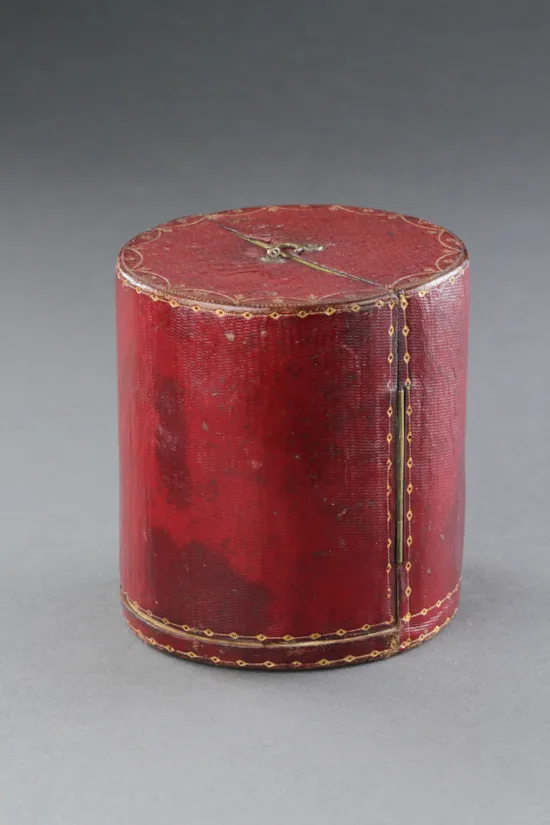Napoleonic Period French Glass Tumbler Housed within the Original Red Morocco Leather Travelling Case
A Napoleonic Period French Glass Tumbler Housed within the Original Red Morocco Leather Travelling Case with Gilt Tooled Decoration
The cut glass tumbler of cylindrical form with a ‘diamond point’ pattern to the side wall
The leather lined traveling case with three brass clasps
Very small old chip to base
Attributed to the Montcenis Crystal Manufacturer France
Circa 1800 - 1810
Size: Tumbler: 8cm high, 7.5cm dia - 3¹⁄₈ ins high, 3 ins dia / 10cm high, 9cm dia. - 4 ins high, 3½ ins dia. (morocco leather case)
The cut glass tumbler of cylindrical form with a ‘diamond point’ pattern to the side wall
The leather lined traveling case with three brass clasps
Very small old chip to base
Attributed to the Montcenis Crystal Manufacturer France
Circa 1800 - 1810
Size: Tumbler: 8cm high, 7.5cm dia - 3¹⁄₈ ins high, 3 ins dia / 10cm high, 9cm dia. - 4 ins high, 3½ ins dia. (morocco leather case)
A Napoleonic Period French Glass Tumbler Housed within the Original Red Morocco Leather Travelling Case with Gilt Tooled Decoration
The cut glass tumbler of cylindrical form with a ‘diamond point’ pattern to the side wall
The leather lined traveling case with three brass clasps
Very small old chip to base
Attributed to the Montcenis Crystal Manufacturer France
Circa 1800 - 1810
Size: Tumbler: 8cm high, 7.5cm dia - 3¹⁄₈ ins high, 3 ins dia / 10cm high, 9cm dia. - 4 ins high, 3½ ins dia. (morocco leather case)
The cut glass tumbler of cylindrical form with a ‘diamond point’ pattern to the side wall
The leather lined traveling case with three brass clasps
Very small old chip to base
Attributed to the Montcenis Crystal Manufacturer France
Circa 1800 - 1810
Size: Tumbler: 8cm high, 7.5cm dia - 3¹⁄₈ ins high, 3 ins dia / 10cm high, 9cm dia. - 4 ins high, 3½ ins dia. (morocco leather case)
The Napoleonic period spanning from November 1799 to June 1815 saw tremendous change in Northern Europe both militarily, politically and industrially. Many fine examples of French glass produced at this time were housed in travelling cases for their protection during journeys in horse drawn coaches while the nobility were on their travels or during military campaigns the officer classes travelled with extensive finery and trappings.
The ‘Montcenis’ firm was established in 1787 and had been the official crystal manufacturers to the monarch during the ‘Ancien Régime’, and would continue to play a significant role in the development of the French glass and crystalware industry.
Even on campaign, Napoleon continued to use objects befitting his rank. At every stop, he demanded the same campaign furniture. The Maison d’Empereur was therefore obliged to ensure the maintenance of Napoleon’s typical routines and, in general, to follow Imperial Palace etiquette scrupulously. Since these objects were of such remarkable workmanship and value, they were generally protected from any accidents that might occur while travelling by carrying cases, themselves finely crafted. Examples of such cases include those for the china ‘Headquarter’s service’ (see: Fondation Napoléon, inv. 792 - 14) and those protecting gold items, including the cutlery bearing the Emperor’s coat of arms (inv. 967). The same applies for the glasswork’s, a gobelet, donated to the Fondation Napoléon by Mr Jean-Claude Lachnitt, also has a cylindrical carrying case. Its interior is lined with green silk, and the exterior is made of brown morocco goat leather decorated in gold with the imperial symbol of the bee, and at the rim, the letter ‘N’ under the imperial crown. The gobelet would have been an everyday object in the Emperor’s bivouac and was probably used during Napoleon’s last campaigns in 1814 and 1815.
The ‘Montcenis’ firm was established in 1787 and had been the official crystal manufacturers to the monarch during the ‘Ancien Régime’, and would continue to play a significant role in the development of the French glass and crystalware industry.
Even on campaign, Napoleon continued to use objects befitting his rank. At every stop, he demanded the same campaign furniture. The Maison d’Empereur was therefore obliged to ensure the maintenance of Napoleon’s typical routines and, in general, to follow Imperial Palace etiquette scrupulously. Since these objects were of such remarkable workmanship and value, they were generally protected from any accidents that might occur while travelling by carrying cases, themselves finely crafted. Examples of such cases include those for the china ‘Headquarter’s service’ (see: Fondation Napoléon, inv. 792 - 14) and those protecting gold items, including the cutlery bearing the Emperor’s coat of arms (inv. 967). The same applies for the glasswork’s, a gobelet, donated to the Fondation Napoléon by Mr Jean-Claude Lachnitt, also has a cylindrical carrying case. Its interior is lined with green silk, and the exterior is made of brown morocco goat leather decorated in gold with the imperial symbol of the bee, and at the rim, the letter ‘N’ under the imperial crown. The gobelet would have been an everyday object in the Emperor’s bivouac and was probably used during Napoleon’s last campaigns in 1814 and 1815.
Napoleonic Period French Glass Tumbler Housed within the Original Red Morocco Leather Travelling Case




















